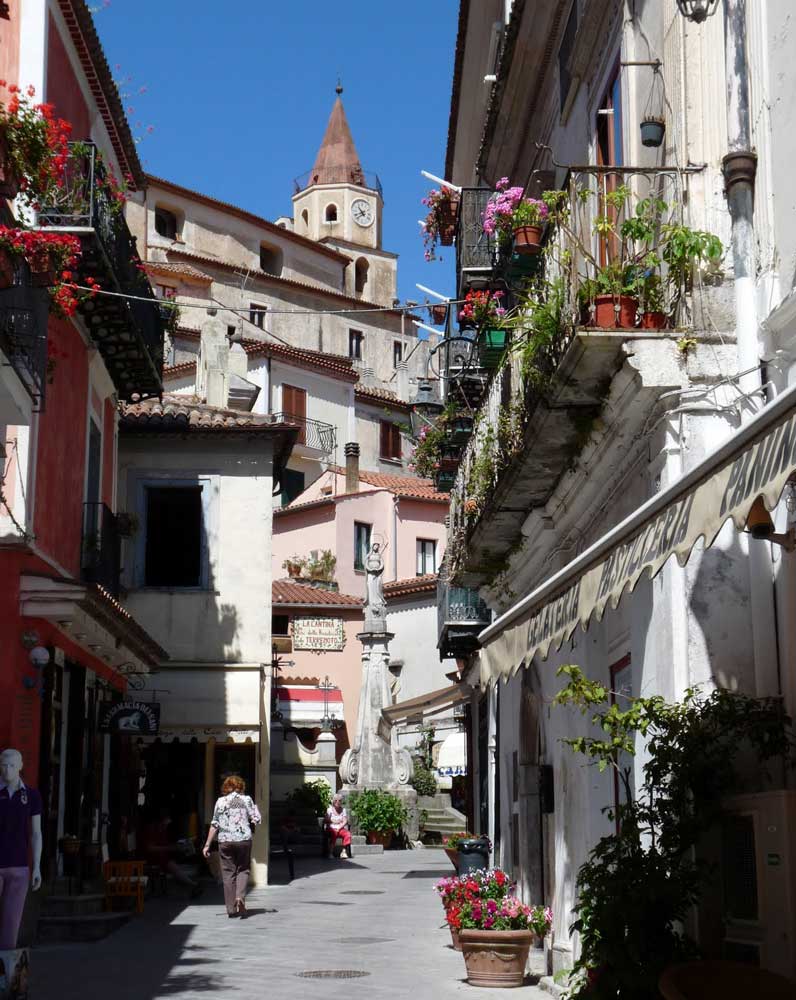About Maratea
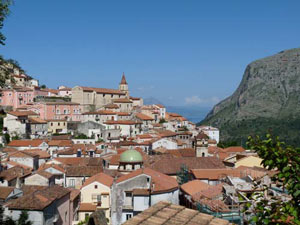
Maratea is a hill village high above the sea on Italy’s southern Tyrrhenian coast, in the region of Basilicata. It’s a good destination for a peaceful longer stay, or for a two or three-night break on a tour of the south. The setting is impressive: below steep wooded slopes, with sparkling glimpses of the sea through a steep pass, and high bare-ridged mountains stretching inland. The area around the town includes little beaches, a marina and a hill crowned by a giant statue of Christ.
A picturesque village with one or two rather smart places to stay, Maratea is both a simple and a refined holiday destination. The town’s small size, steep slopes and distance above the sea mean it is unlikely ever to become a mass-tourism destination. It is a holiday spot for Italy aficionados, and for those in tune with the rich but slow pace of Italian life. Like the cave-town of Matera, Basilicata’s other leading tourist destination, Maratea still has a real sense of history, and enterprising travellers will discover crumbling buildings and overgrown lanes where the smartening-up process hasn’t yet reached.
Maratea geography
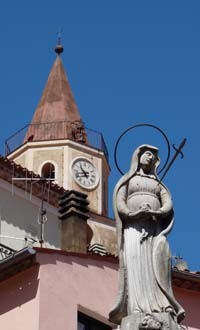
Maratea is a sprawling comune (administrative area) incorporating several different settlements. Maratea proper, the old village or borgo, is in the hills far above the sea; a giddying location with views over the Gulf of Policastro below and cloud-shrouded ridges above. Dominating everything is Christ the Redeemer, Il Redentore, a huge white statue opening his arms in benediction. The historic village of Maratea is the most appealing place to stay. Down by the sea, Maratea Porto is a harbour which has recently been somewhat over-developed as a posh leisure marina and outdoor art exhibition, and Fiumicello and Marina di Maratea are little beach resorts. A couple of miles to the north is Acquafredda, another seaside settlement with a beach. Maratea railway station is between Maratea, Fiumicello and Maratea Porto, while Acquafredda and Marina di Maratea have their own stations. Detailed information on transport can be found further down this page.
If you are considering Maratea as a holiday destination, bear in mind that the town’s setting is on the hillside and the town centre is composed of little sloping lanes and staircases. Consequently, exploring could pose problems for travellers with reduced mobility.
Maratea tourist information
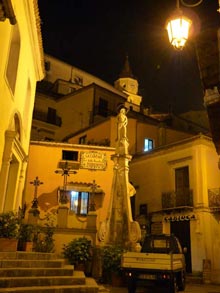
Maratea has been developed sensitively as a tourist destination, but surprisingly there is (at the time of writing) no tourist information office in Maratea itself. There is, however, an office on the bending road below town which leads to the railway station; practical for drivers though not for car-free travellers. Luckily, there are shops and a travel agency in the heart of Maratea which sell little maps of the area and photographic guides, and you don’t need much background information to enjoy exploring the small town.
Tourist sights and things to do
The best activities in Maratea are exploring the little lanes, and then sitting at an outdoor cafe in the charming main square, Piazza Buraglia, and watching the world go by. The town is attractive both by day and by night, and you can spend several hours wandering up and down narrow lanes discovering picturesque corners and sudden views. This is a good spot for photographers and for lovers of the little details of Italian life: crumbling grand archways, religious icons tucked into niches and grottoes, elderly locals exchanging gossip in the piazza and lazy resident cats dozing in alleys.
Maratea boasts that it is the town of 44 churches. The three well-kept churches near Piazza Buraglia, the Chiesa dell’Addolorata, the Chiesa dell’Immacolata and the Chiesa dell’Annunziata, are generally open and are worth visiting for their provincial artworks and an atmosphere which is both quaint and devout. They’re all dedicated to the Virgin Mary in different roles. The most historically-important church, the Chiesa Madre (this one again dedicated to Santa Maria Maggiore), is further uphill, but, like the many smaller chapels and churches, you may not find it open. One of the most striking chapels, on a small street below the heart of town, is the Chiesetta del Calvario. In its facade is set a fresco of the Madonna and saints dating to 1548, and through an opening in the door it is possible to admire more attractive frescoes inside.
Piazza Buraglia is a quieter version of Capri‘s famous piazzetta; an elegant village square dotted with cafe tables. A narrow street connects it with Piazza Vitolo. Between the two squares are a variety of shops, two churches and a statue of the town’s patron saint, San Biagio, on top of a column. Piazza Vitolo is almost as appealing as Piazza Buraglia. One side of the square is dominated by the stately town hall, and in the centre is an elegant fountain, unfortunately used as an occasional roundabout. A couple of restaurants look out on the square, with upstairs terraces from which you can enjoy the evening scene while eating.
Other sights to look out for while you are exploring the town are a set of frescoes in an open-air chapel near the Convento dei Cappuccini, several medieval towers and romantically ruinous buildings as well as temptingly-renovated ones. The oldest part of the town is on a knoll around and above the Chiesa Madre. You’ll come across some very old doorways and buildings in this part of Maratea, including the oldest church, the eleventh-century Chiesa di San Vito, which lies along an overgrown path by the woods.
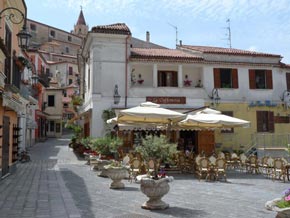
Maratea has a small town museum (Museo Comunale), although it does not have regular opening times all-year-round. If you are interested in visiting, ask advice at your hotel or the tourist office as it may be possible to visit on request, with advance notice. The contents include various exhibits related to the local area, including Roman anchors and other finds from the Isola di Santo Ianni. The Isola is a tiny island close to the coast near Maratea, which appears to have been used by the Romans as a trading anchorage and for the production of garum, the fish sauce they loved. Ruins, jars, and many anchors have been found here by archaeologists and divers.
The biggest events in Maratea are celebrations for San Biagio, which take place in May, and a summer programme of events which range from a jazz concert to food tastings.
Places to eat and drink
The central part of Maratea is quite small, and there are only a few places to eat and drink. The choice is good enough to provide some variety, though. Around Piazza Vitolo there are several affordable restaurants, aimed mostly at tourists but offering decent food in a nice setting, including La Torre, which overlooks the square. A smarter option, specialising in local dishes, is the Taverna Rovita (Via Rovita), which is hidden down an alley. The restaurant of the Locanda delle Donne Monache has a formal atmosphere and is expensive, but is worth it for the good food and service. We enjoyed basic and very cheap lunches at Il Ghiottone (Via Pietra del Pesce), where you can order plates of pasta or filling rolls along with a beaker of local red wine at budget prices. There are six tables, friendly staff, and both an eccentric mural and a lace image of Italian saint Padre Pio decorating the walls. The nicest bar is almost certainly La Caffeteria in Piazza Buraglia, where you can order a morning coffee, an afternoon snack or an evening aperitivo sitting right in the heart of the town.
The Redentore and a short walk
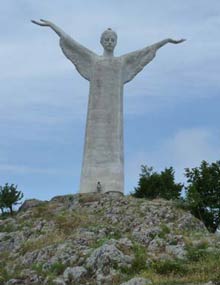
It is definitely worth ascending the hill above town, Monte San Biagio, to visit the giant statue of Christ the Redeemer, Il Redentore. The 22-metre-high statue faces inland, arms outstretched to bless this historically impoverished part of southern Italy. More immediately blessed is the big church at the opposite end of the ridge dedicated to Maratea’s patron saint, the Basilica di San Biagio. This church is thought to stand on the site of a Greek or Roman temple; the Greek settlement which was the precursor of Maratea was on the slopes just below the summit. The hilltop can be reached on foot or by car – if you are feeling just moderately energetic, I’d suggest getting a taxi up and then enjoying a pleasant walk back down. As well as religious benefits, the statue was probably intended to bring some prestige to the region when it was erected in the 1960s, and the dramatically-engineered road on stilts which zig-zags to the top was perhaps a source of as much pride as the statue. Between the church and the statue there is a tacky souvenir shop and a bar. Just below the summit is something more evocative than either statue or church; an abandoned village. This would have been the site of the Greek settlement, and it continued as an earlier incarnation of Maratea, until the town’s main hub shifted to its current, more accessible location. The castle by the hilltop was destroyed in the nineteenth century. Nowadays this village, called Maratea Superiore, is a little ghost town, having been gradually abandoned. You can peer into crumbling buildings where paint peels from the walls, and walk down the silent main street. At the lower end, near the road, a couple of inhabited buildings sit side-by-side with ruins.
If you are walking back down to Maratea, join the road at the foot of the ruins, and follow it for a few bends. Turn off onto a a path to the right as you approach the hamlet of Santa Caterina. A historic connecting route between the old settlement and the current one, this is a very pretty path curving below the summit of the hill, through slopes alive with flowers and butterflies. It passes several extremely intriguing old caves, fenced off and with no official access. Caves in this area have been the source of interesting artefacts and one or two – including the Grotta dell’Angelo near the summit – contained faded religous wallpaintings. The footpath joins the road above Maratea and a few yards further on another lane cuts through the oldest part of the present settlement, where some buildings aren’t in much better shape than the ruins on the hill above. This is an interesting and attractive walk, and an easy one, though you will need good-soled shoes. We saw wild boar in the woodland above town.
There is an alternative footpath between Maratea and Monte San Biagio, which ascends the other flank of the hill, and passes another church dedicated to Mary, the Chiesa della Madonna degli Ulivi (Madonna of the Olives).
Around Maratea
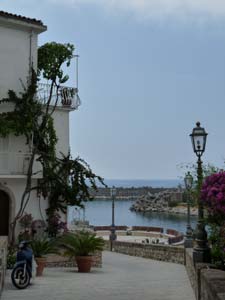
The settlements around Maratea are interesting to visit or to tour by car or by the little local bus. Maratea Porto is a picturesque place to wander, take a boat trip, look at boats or enjoy a leisurely rest at a harbourside cafe. The village and marina have been developed for tourists, with lots of outdoor cafe seating and works of art displayed around the lanes. It still retains some more old-fashioned charm, though, with little fishing boats moored beyond the smart yachts, and elderly men playing cards at a rickety table next to a statue of the Madonna.
The bus route connecting Maratea and Maratea Porto also passes through Fiumicello, where there is a little beach. It continues along a scenic coastal road to Castrocucco, a short walk from another stretch of beach. It’s worth taking this bus ride just to see the views of the coast, hillside and ruined castles which used to guard the shore.
Just south of Castrocucco is Praia a Mare, a larger seaside resort. Inland days out from Maratea could include walking in the hills, or visiting the picturesque hill-town Rivello, reachable by car or by bus.
Activities in the Maratea area include walking and seaside options like boating – with rocky coastline, coves and caves to explore – and diving. The Centro Sub Maratea, based in Santa Caterina, offers diving courses and excursions. During the holiday season it is also possible to hire boats or go on a sailing or fishing trip.
Maratea travel and transport
Maratea is on the railway line which heads south from Naples towards Reggio di Calabria. The railway station, situated on a rare spot of level ground where the tracks emerge from a tunnel, is a long way below Maratea and travellers will need another form of transport to reach their accommodation. The station is on the route of local buses, but it would probably be more convenient to arrange transport with your hotel. Be aware that the ticket office only has limited opening times and you should try to buy your onwards train ticket in advance – on arrival, in a travel agency (there is one close to Piazza Vitolo) or online.
There is a little local bus, as mentioned above, which connects Maratea with the railway station, Fiumicello, Maratea Porto and Castrocucco. This is a great way to tour the coast and very good value, too at just 60 cents for a single ticket (pay on board). If you check timetables you can hop on and off to explore Maratea Porto – which is worth visiting – and Fiumicello. You could just opt for a panoramic ride. The most central bus stop in Maratea is at the corner of Piazza Vitolo, and timetables are printed on the stop. There are a couple of other routes, one reaching as far as Acquafredda, but these run rarely and you should check the latest timetables (see our links panel).
Accommodation
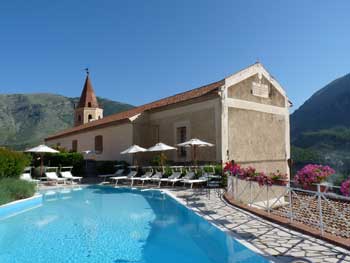
We stayed at the Locanda delle Donne Monache, a smart and welcoming hotel in a central position (up a few lanes from Piazza Buraglia) with a swimming pool and garden. It’s a highly recommended option, but if you are looking for something simpler, the Hotel Capo Casale is a three-star hotel with good reviews and cheaper prices close to the Locanda. For a seaside holiday, you could consider one of the hotels a short drive away down the hillside nearer the sea: the Romantik Hotel Villa Cheta Elite or the Hotel Gabbiano, which is right on the beach at Acquafredda.
Basilicata region
Locanda di San Martino, Matera
Locanda delle Donne Monache, Maratea
On this site
South to Calabria: a travel itinerary including Maratea
Matera – Basilicata’s ‘cave-town’
Useful external links
Sita buses (the local service: Urbano Città di Maratea)
